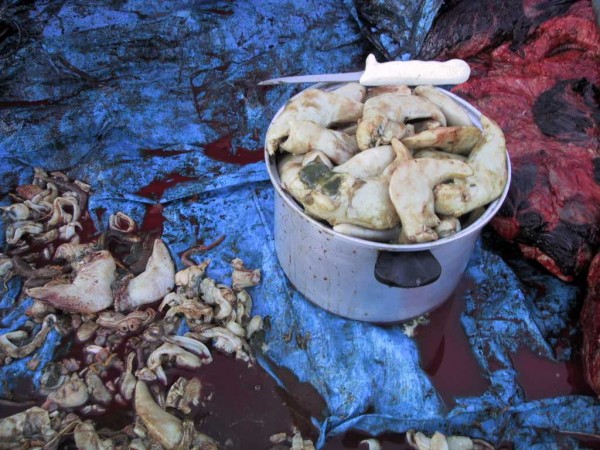Biotoxins may affect human use of Arctic mammals
February 24, 2016
Deborah Mercy
907-274-9698

Just the thought of harvested seal or walrus being contaminated with biotoxins is a big concern for Alaska residents who feed them to their families. But warmer temperatures in the Arctic are creating favorable conditions for toxin-producing harmful algal blooms and making this a reality.
It is not known if algal toxins have always existed in the Arctic, but a recently published paper in the journal Harmful Algae reports that the toxins found in certain types of plankton are present in northern marine mammals.
The two most common algal toxins are domoic acid and saxitoxins. In 2015, both biotoxins caused significant illness and mortality in marine mammals along the U.S. Pacific coast. However, to date they have not been known to commonly exist in marine mammals foraging throughout Alaska waters.
Gay Sheffield, Alaska Sea Grant Marine Advisory agent in Nome, is a co-author on the paper. Sheffield provided samples for the study from ice-associated seals both harvested for subsistence and stranded dead in the Bering Strait region.
While the amounts of toxins in the marine mammals do not exceed regulatory limits for food safety, their presence does generate food security concerns for the people of the Arctic.
Sheffield wonders if these toxins have always been in the Bering Strait. “Are these types of plankton new, or are they just what we’ve had all along? The project results don’t answer that but they do provide baseline data regarding low levels of biotoxins in northern marine mammals,” Sheffield said.

Sheffield recommends a more comprehensive investigation that identifies regional traditional knowledge about shellfish poisoning, algal blooms and unusual marine mammal behavior.
“To be more relevant and comprehensive to our coastal communities, we need to understand what traditional knowledge already may be available regarding algae and shellfish issues,” Sheffield said. “The integration of regional traditional knowledge with laboratory results from the marine mammal tissues — it seems like that would be useful to everyone.”
Sheffield has also asked that the paper be translated into Russian so it can be shared with neighbors on the western side of the Bering Strait. NOAA agreed to translate the press release.
“We can put it on the Internet, we can get it to the Chukotka Native marine mammal hunting associations, coastal communities, as well as their Russian marine biologists,” said Sheffield. “The Bering Strait is a shared waterway, and the populations of marine wildlife, seabirds, fish, clams, walruses, seals, sea lions and whales do not need a passport to travel across the border to either shore. It is ethically responsible to share this new information with our neighbors, and that may help further our understanding of what is happening in our waters throughout the Bering Strait region.”
The study was a collaborative effort between government agencies, organizations, coastal communities and the harvesters.
ADDITIONAL CONTACTS: Gay Sheffield, 907-443-2397, gay.sheffield@alaska.edu; Kathi Lefebvre, 206-302-2454, kathi.lefebvre@noaa.gov
ON THE WEB: http://www.nwfsc.noaa.gov/


